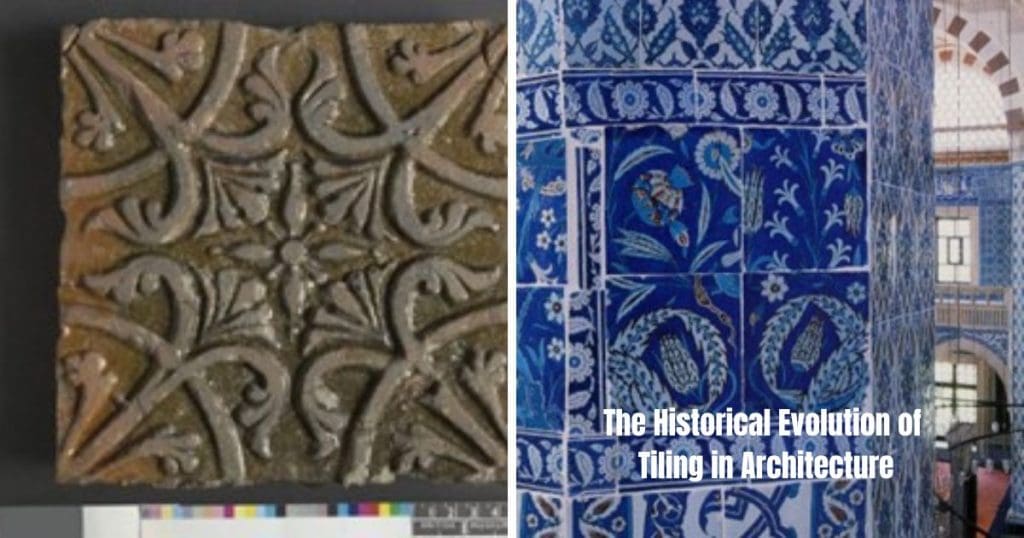The origins of tiling can be traced back to earlier civilizations like Mesopotamia and Egypt. History shows that as far back as 4,000 BC, ornamental tiles were used for the first time. Early tiles, which were frequently made of clay or stone, were not only useful for shielding buildings from the elements, but they were also widely regarded as works of art.
Tiles were employed to adorn temples in Mesopotamia in order to beautify the landscape, and mosaics, which told tales of gods and kings, became a prominent style of art in ancient Greece. Tiles are less symbolic today than they once were as they’re mostly utilized to adorn the interior of homes in the present day. Continue reading embark on a journey through time, exploring the evolution of tiling in architecture from the ancient times of the past until today.
Ancient Beginnings
Mesopotamia: The Origins of Tiling
Tiles were used in Ancient Mesopotamia to decorate temples and palaces. Made from clay and baked in kilns, tiles commonly depicted stories of gods, battles, and daily life. An example is the Ishtar Gate, commissioned by King Nachbuchanezar II (image below).
The glazed bricks form a beautiful blue background for tile designs featuring animals and deities. The tiles were given their colour through the use of cobalt glaze. That was common at the time for most structures. The ziggurat of Ur, for instance, showcases magnificent blue tiles that shimmer in the sun. Next, let’s explore ancient Egypt tiling.

Ancient Egypt: Hieroglyphs and Tiles
World renowned for their pyramids and hieroglyphs, the Egyptians used tiles in tombs, religious temples, and pyramids to adorn the ceilings and walls. These tiles, often made of faience, a glazed ceramic, bore inscriptions and images of deities. The vibrant colours and intricate designs primarily reflect Egyptian culture and religious beliefs. The images below show just a few examples.
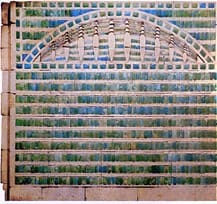

Next, we’ll discuss the classical era.
The Classical Era
Greek Geometric Patterns
The ancient Greeks, with their pantheon of gods and love for geometry, incorporated tiles into their temples and homes. It’s known as “tesserae.” Wondering what that means? Tesserae consists of small marble, glass, and/or tile pieces that were used to create mosaic art.

These tiles, often in shades of blue and white, showcased geometric patterns, mythological scenes, and even scenes from daily life. Tiling could commonly be found on the floors and walls of private homes and sometimes in public buildings. This practice was only partially new. Mosaics can be traced back to 3,000 BC in Ancient Mesopotamia, where seashells, ivory, and stones were arranged to make tiling art. Let’s learn about the Roman influence next.
The Roman Influence
Known for their grand architectural feats, the Romans left an indelible mark in the world of tiling. They introduced intricate designs and patterns, as reflected in thermal baths and aqueducts. Luxury was a staple in Roman life, so it seems only natural that tiles played a part in showcasing lavishness. Travertine, a form of limestone, was often used in tile work at the time. What’s a good example? A good example is the Colosseum, which still stands proudly today.
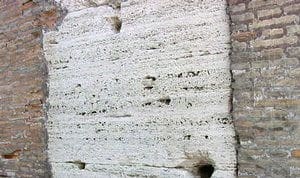
Their use of tiles in public and private spaces set a precedent for future European architectural styles. Indeed, the Romans were primarily responsible for bringing tiling techniques to Europe.
The Medieval Period
Medieval Europe and Tiling
Tiling did somewhat fall out of popularity during the medieval time (which was from 476 A.D. until around the 14th century) as architecture embraced less sophisticated techniques like timber frames and thatched roofs. Tiling didn’t start again until around the second half of the 12th century, with developments occurring in Germany and Britain (and would slow again about two centuries later, thanks to the Black Plague).
One early medieval tiling technique was known as “relevare,” which means “to raise”; in English, it’s better known as ‘relief tiles.’ It involved pressing stamps into the clay before firing and glazing the tiles. Below is an example of a high-relief tile.
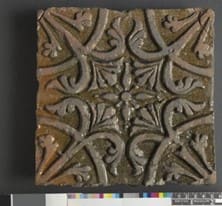
Ceramic roof tiles also regained their popularity (it fell out of everyday use after the decline of the Roman Empire), and tile makers would create these by rolling out clay on a sanded table.
Tiling during the medieval period definitely took on a more religious tone. Cathedrals and churches were adorned with Gothic-inspired tiles, often depicting biblical scenes. Mosaics remained popular, especially in places of worship, symbolizing the grandeur of the divine. The art of tiling was limited to floors, walls, and ceilings. However, due to its cost, only royal places, the church, and the homes of the wealthy would adorn their structures with it.
The “two-colour” tiles decorated with religious images and floral patterns were a significant innovation that allowed this development. Checkerboard patterns were popular in royal palaces like Versailles, which brings the discussion to the Renaissance.
The Renaissance and Tiling
The Renaissance, a period of rebirth in art and culture, witnessed a transformation in tiling. Italy, the heart of the Renaissance, saw palaces and public spaces adorned with tiles that reflected the era’s artistic flair. Artists and architects collaborated to create masterpieces, blending functionality with aesthetics.
Renaissance architects primarily derived their designs and inspirations from ancient Greece and Rome. Most architectural structures were built around geometric shapes, the most important being the circle, as reflected in the arches, domes, and vaults typical of the structures at this time. Why was the circle important? Circles were thought to create a sense of harmony and balance. Let’s see what was happening with tiling in the East.
Tiling in the East
China
Architectural tiles were often used to decorate palaces, mausoleums, imperial gardens, and temples in ancient China. The use of tiles in the region can be traced back to the Northern Wei Dynasty (36-534AV). Tiles were used on building roofs (Wadang in Chinese) and walls (Yingbi in Chinese). Often, they were made from loess and produced through a double-firing process.
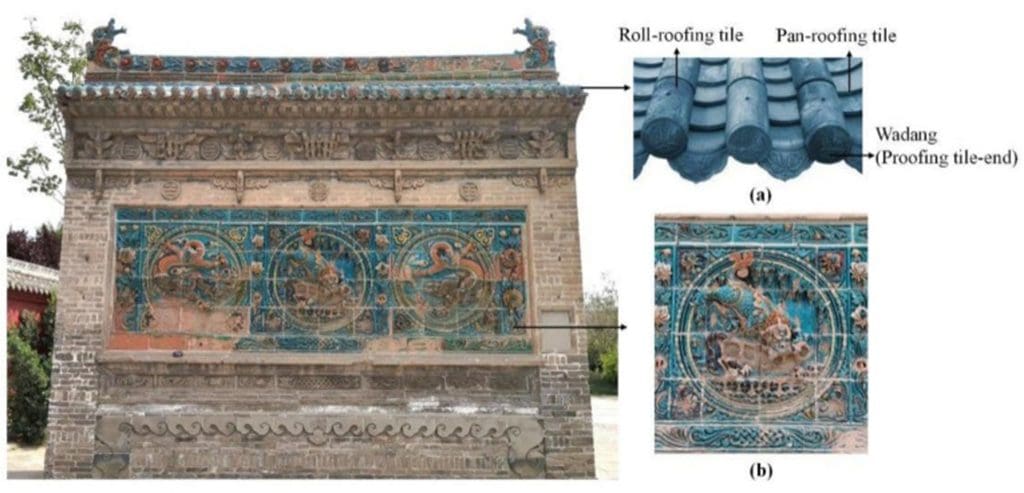
Porcelain tiles would later become a symbol of elegance and sophistication. Porcelain tiles, known for their durability and sheen, were exported worldwide, largely thanks to the trade conducted on the Silk Road. Next, we’ll turn to what tiling techniques were used in the Islamic world.
The Islamic Golden Age
Meanwhile, tiles became a medium to express a rich artistic heritage in the Islamic world. Highly intricate geometric patterns and designs, Arabian motifs, and calligraphy graced the walls and ceiling of various places, from mosques to palaces, during a period known as the Islamic Golden Age (which lasted from about the 8th century to the 13th century). Turkey is also famously known for Iznik tiles that adorn architectural structures like the Rustem Pasha Mosque in Istanbul. Let’s fast-forward to the modern era.
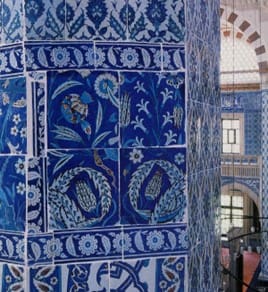
The Modern Era
Tiling in Industrialization
The Industrial Revolution brought about the mass production of tiles. Owing to advances in automation, particularly the development of a conveyor system that took the tile through a tunnel kiln, applying an even glaze, cooling and boxing them in as little as two hours, the cost of production was drastically reduced and tiles were made widely available.
How long did it take to produce tiles before, you wonder? Before this invention (circa 1940), producing one tile could take more than 70 hours from start to finish. So, it was in the 1950s that tiles became a staple in Western homes. Factories also began sprouting all over the West, meaning tiles could be produced on a larger scale to cater to the growing urban population.
Modern and Contemporary Tiling
Tiling significantly evolved in terms of materials, designs, and functionality throughout the 20th and 21st centuries in the West. However, art movements and ideologies still played a notable role in features and elements. Take the Art Nouveau and Art Deco movements as an example. These two movements made geometric designs and abstract patterns more popular, while tiling patterns from the Victorian Era reflected a love for nature, with floral and fauna motifs being the most popular.

Today, tiles are more popular than ever, not only because they make the home appear beautiful but also because of hygiene. Ceramic tiles are much easier to clean, making business sense, too.
And as in ancient times, in today’s day and age, it’s easy to see how modern ideas factor into the production of tiling. Many are, for instance, made from recycled materials, reflecting a common concern for sustainability. Changes in technology unleash the power of digital design, which allows for more intricate and personalized patterns. The development of smart tiles is another innovation, where ‘tiles’ are meant to look as such but they come with a peel and stick backing.
What does the future hold for tiling? Let’s find out!
The Future of Tiling in Architecture
Looking ahead, the future of tiling in architecture certainly seems promising. With a focus on eco-friendly materials and innovative designs, tiles will continue to play a pivotal role in shaping the built environment. The possibilities are endless, from smart tiles that can create electricity to those that can harness solar energy.
Tile Setters: the Unsung Heroes
The evolution of tiling in buildings, from ancient Mesopotamia to modern designs, underscores the importance of both human inventiveness and finding the right tile setter. With a rich history dating back to ancient times, tiles will continue to adorn our spaces. As we approach new architectural advances, the mastery of the past and the promise of the future merge, highlighting the significance of craftsmanship and innovation.

